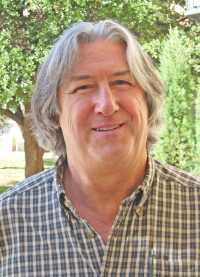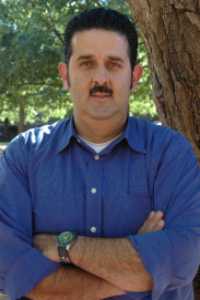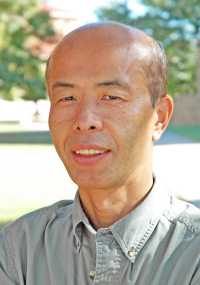Strategic Faculty Hires

Matt Olson
>Associate Professor, Department of Biological Sciences
Matt Olson, Associate Professor, Department of Biological Sciences, studies population
genetics, which is a branch of evolutionary biology focused on how genetic changes
spread through populations across generations. This field of study aids in identification
of genetic-based diseases and has contributed to understanding the origins and spread
of human beings and genealogical relationships. Olsen, however, uses these techniques
to study the history of cottonwood trees and identify genes for improving growth
and yield. At present he is working to identify the genes that control when trees
stop growing and drop their leaves in the fall. Harnessing this information will
allow breeders to develop fast-growing trees for a variety of different climates.
Olson is an integrated scholar who also works and teaches in the fields of genomics
and computational biology. His research requires whole-genome sequencing techniques
that generate a tremendous amount of data and can only be organized and understood
via powerful computational techniques. He aims to help develop graduate and undergraduate
programs in genomics and bioinformatics at Tech.

William Resetarits
Professor, Department of Biological Sciences
William Resetarits, Professor, Department of Biological Sciences, comes to Texas
Tech after serving as Program Director in the Division of Environmental Biology at
the National Science Foundation and as a Visiting Scholar at Rutgers University.
Professor Resetarits' research lies at the intersection of ecology, behavior and
evolution and has primarily focused on aquatic systems and the aquatic/terrestrial
interface. He is keenly interested in biodiversity and species interactions and
their role in community and ecosystem function at multiple spatial scales.
In explaining further his research, Resetarits adds, "My goal is to continue to examine
the mechanisms that determine the distribution and abundance of species in natural
systems. These mechanisms range from the dynamics of individual behavior, through
evolutionary history, to processes operating at the landscape scale, all of which
contribute to determining patterns of biological diversity. Because my work is rigorously
experimental, yet strongly field and organism based, it has that compelling combination
of the cerebral and the tactile, the theoretical and the tangible, that engage students
at all levels."

Yehia Mechref
Associate Professor, Department of Chemistry and Biochemistry
Yehia Mechref, Associate Professor, Department of Chemistry and Biochemistry, uses
the example of common table sugar to introduce his research area by saying, “Table
sugar is the first thing that comes to mind when the word ‘sweet' is mentioned; however,
sugars do a lot more than making coffee taste good. Table sugar is part of a complex
class of biomolecules known as carbohydrates and glycans.” He goes on to say that
“they play major roles in many important biological functions such as immune response,
cell development, cellular differentiation/adhesion and host-pathogen interactions.
Moreover, aberrant glycosylation for decades has been recognized as the attribute
of many mammalian diseases, including osteoarthritis, cystic fibrosis and cancer.”
Mechref has been working for years on the development of mass spectrometric
bioanalytical approaches that allow the detection of changes in the carbohydrates
attached to blood proteins to detect cancer at early stages. According to Dr. Mechref,
“The ability to detect the changes in these ‘sweet' molecules is going to allow better
understanding of cancer development and progression which will subsequently permit
early detection of this disease.” Dr. Mechref's group is currently working on defining
sugar structures that will allow distinguishing different cancer types.

Juske Horita
Professor, Department of Geosciences
Dr. Juske Horita, Professor, Department of Geosciences, has more than twenty years experience in studying environmental, hydrological and other Earth processes, utilizing natural tracers of stable isotopes. The stable isotopes are variants of chemical elements such as hydrogen, oxygen, carbon, and nitrogen, but with different atomic weights. Subtle, yet measurable, variations of these stable isotopes provide very useful tools for understanding dynamic and complex natural processes, and this technique has been finding an increasing number of applications in many scientific fields, including archeology and forensic sciences.
Dr. Horita plans to expand his research projects to issues very crucial to West
Texas and the Southwestern U.S., including water resources, and other environmental
and ecological areas. He is also developing an interdisciplinary research facility
and courses to attract researchers and students from across the Tech campus and beyond.
In addition to being a renowned scientist, he is dedicated to teaching, and says
that he “wants to promote the participation of undergraduate students in research
through the Honors College and other interdisciplinary programs. “
College of Arts & Sciences
-
Address
Texas Tech University, Box 41034, Lubbock, TX 79409-1034 -
Phone
806.742.3831 -
Email
arts-and-sciences@ttu.edu
